Notes: Appleton Station was situated on the St Helens & Runcorn Gap Railway’s (SH&RGR) line which ran southward from St Helens to the banks of the Mersey at Widnes. The station was less than half-a-mile to the east of Appleton village which, by the latter half of the nineteenth century, had become a district of the town of Widnes.
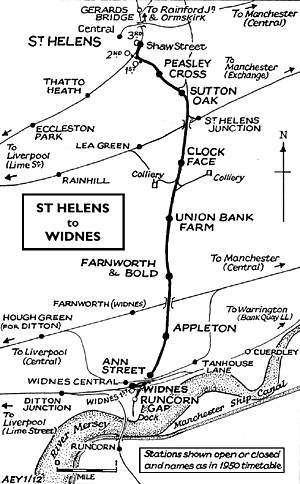 The SH&RGR opened its line on 21 February, 1833 and it had given no thought to the provision of passenger services as it was built primarily to move coal from the St Helens area down to the banks of the River Mersey at Widnes Dock. Following the success of passenger services on the Liverpool & Manchester Railway (L&M) which opened in September 1830 the SH&RGR had been persuaded by local people to run a passenger service between St Helens Junction (on the L&M line) and St Helens, the northern terminus of its own line, as early as 1832 before it had opened as a through route. There was also pressure to operate a service between St Helens and Runcorn Gap. The company was persuaded, and they therefore hired two coaches from the Liverpool & Manchester Railway (LMR) at £1 per week. The SH&RGR did not operate specific passenger trains but merely attached the coaches to goods services. The only stations were at St Helens and close to Widnes Dock, the latter being named Runcorn Gap. The SH&RGR opened its line on 21 February, 1833 and it had given no thought to the provision of passenger services as it was built primarily to move coal from the St Helens area down to the banks of the River Mersey at Widnes Dock. Following the success of passenger services on the Liverpool & Manchester Railway (L&M) which opened in September 1830 the SH&RGR had been persuaded by local people to run a passenger service between St Helens Junction (on the L&M line) and St Helens, the northern terminus of its own line, as early as 1832 before it had opened as a through route. There was also pressure to operate a service between St Helens and Runcorn Gap. The company was persuaded, and they therefore hired two coaches from the Liverpool & Manchester Railway (LMR) at £1 per week. The SH&RGR did not operate specific passenger trains but merely attached the coaches to goods services. The only stations were at St Helens and close to Widnes Dock, the latter being named Runcorn Gap.
The passenger service was very slow due to the line being single-track but also because there were two inclined planes up and down which trains had to be worked by means of a cable. The inclines were far too steep for locomotives to climb; one was immediately north of the point where Appleton station was later built, and the other was at Sutton, near St Helens.
Due to fierce competition with a canal, the Sankey Navigation, the SH&RGR was not a financial success. To overcome the problem the railway and canal companies merged with effect from 21 July 1845 as the St Helens Canal & Railway Company (SHC&RC). This improved the financial situation, and both the railway and the canal became profitable. The company then turned its attention to carrying out improvements. On 22 July 1847 they received Royal Assent to create a double-track railway and to level out the inclined planes so that locomotives could work the entire length of the line.
The inclined plane to the north of Appleton was levelled out, and the new alignment was ready for traffic by the end of 1850. Shortly afterwards five intermediate stations opened along the line, all of which first appeared in the public timetable in June 1852.
 Appleton station was on the north side of a level crossing with two platforms. It had a simple single-storey brick building on the ‘up’ (St Helens direction) platform and a simple waiting shelter on the ‘down’ Widnes direction platform. A house for the stationmaster was provided on the east side behind the southbound platform. A small area of settlement, including two inns, developed around the station. Appleton station was on the north side of a level crossing with two platforms. It had a simple single-storey brick building on the ‘up’ (St Helens direction) platform and a simple waiting shelter on the ‘down’ Widnes direction platform. A house for the stationmaster was provided on the east side behind the southbound platform. A small area of settlement, including two inns, developed around the station.
At the time of opening passenger trains would have operated between Runcorn Gap and St Helens. By July 1852 the SHC&RC had opened an extension of the line from Widnes to Garston, and some of the passenger train services ran on to the latter route.
On the 31 July 1864 Appleton station became part of the London & North Western Railway (LNWR). The company made further improvements to the line, which had become a very busy artery for freight. By the 1880s the level crossing immediately south of the station had been replaced with an overbridge to the north of the station. Also the town of Widnes, by then a booming chemical manufacturing base, had spread to the west side of the line at Appleton station. To cater for the sidings a signal box was opened on the west side of the line to the south of the station in 1879. It was a Saxby & Farmer type 6 box brick structure.
By 1890 Appleton signal box had opened east of the line, at the north end of the down platform. Passenger train services had settled into being very much of a local nature although excursions to further afield locations did run. The December 1895 timetable showed Appleton as having nine up and eight down trains Monday-to-Friday as shown in the table below. There was an extra down train on Saturdays and three trains in each direction on Sundays.
| Up Trains (St Helens direction) December 1895 |
Destination |
Down Trains (Ditton Junction direction) December 1895 |
Destination |
| 7.20am |
St Helens Shaw Street |
6.50am |
Ditton Junction |
| 9.45am |
St Helens Shaw Street |
9.01am |
Ditton Junction |
| 12.18pm |
St Helens Shaw Street |
11.40am |
Ditton Junction |
| 2.19pm |
St Helens Shaw Street |
1.45pm |
Ditton Junction |
| 3.40pm |
St Helens Shaw Street |
3.05pm |
Ditton Junction |
| 5.34pm |
St Helens Shaw Street |
4.47pm |
Ditton Junction |
| 6.50pm |
St Helens Shaw Street |
6.20pm |
Ditton Junction |
| 9.00pm |
St Helens Shaw Street |
8.24pm |
Ditton Junction |
| 10.15pm |
St Helens Shaw Street |
11.20pm (Saturdays Only) |
Ditton Junction |
The LNWR opened a new signal box at Appleton located on the east side of the line north of the station in January 1904. It was an LNWR type 4 box with a brick base and timber upper cabin. It was equipped with an 18 lever frame. By 1910 a saw-mill had opened adjacent to Appleton station, on the west side of the line. The mill was provided with its own siding which connected into the main line just north of the station.
From 1 November 1911 the LNWR introduced a rail-motor service on the line, and to coincide with its introduction they opened two halts, one of which was Ann Street, just over a mile south of Appleton. The service was very popular with local people and was given the name of ‘Ditton Dodger’ as it ran between Ditton Junction and St Helens Shaw Street. At Ditton Junction connections to Liverpool, Crewe, Manchester and even London could be made. It was not long before the rail-motor was inadequate for the service, and it was replaced with Webb tank locomotives and coaches which could be operated as push-and-pull sets. However the name ‘Ditton Dodger’ stuck until the service ceased to run. By July 1922 there were ten up and nine down services on weekdays as shown in the table below. Sunday services had ceased to run.
| Up Trains (St Helens direction) July 1922 |
Destination |
Down Trains (Ditton Junction direction) July 1922 |
Destination |
| 7.14am |
St Helens Shaw Street |
6.43am |
Ditton Junction |
| 9.14am |
St Helens Shaw Street |
8.54am |
Ditton Junction |
| 10.18am |
St Helens Shaw Street |
11.39am |
Ditton Junction |
| 12.14pm (Saturdays Only) |
St Helens Shaw Street |
2.30pm |
Ditton Junction |
| 12.25pm |
St Helens Shaw Street |
3.29pm |
Ditton Junction |
| 2.59pm |
St Helens Shaw Street |
4.50pm |
Ditton Junction |
| 4.14pm |
St Helens Shaw Street |
6.37pm |
Ditton Junction |
| 5.29pm (Saturdays Excepted) |
St Helens Shaw Street |
9.05pm |
Ditton Junction |
| 5.40pm |
St Helens Shaw Street |
10.02pm (Saturdays Excepted) |
Ditton Junction |
| 7.09pm |
St Helens Shaw Street |
10.22pm (Saturdays Only) |
Ditton Junction |
| 9.48pm |
St Helens Shaw Street |
|
|
On 1 January 1923 Appleton station became part of the London Midland & Scottish Railway (LMS). Very little changed, however, and the service continued between Ditton Junction and St Helens Shaw Street. The LMS summer timetable for 1932 had thirteen trains leaving Appleton for St Helens and the same number to Ditton Junction on weekdays; additional trains ran on Saturdays. During the 1930s many excursion trains ran from Appleton including Rugby League specials and Sunday school outings from the nearby St Ambrose Church.
 During the Second World War the passenger service was cut back to only six trains per day in each direction, and they ran only in morning and evening peak hours. There were midday services on Saturdays for shoppers but, in the main, the line was given over to goods services and troop trains. At the end of the war Appleton’s passenger service remained sparse, although the trains that did run were popular with local people for travelling to work and on Saturday shopping trips. During the Second World War the passenger service was cut back to only six trains per day in each direction, and they ran only in morning and evening peak hours. There were midday services on Saturdays for shoppers but, in the main, the line was given over to goods services and troop trains. At the end of the war Appleton’s passenger service remained sparse, although the trains that did run were popular with local people for travelling to work and on Saturday shopping trips.
On the 1 January 1948 Appleton became part of the nationalised British Railways (London Midland Region). The 1949 summer timetable had only six up and six down trains Monday-to-Friday, with a long gap during the daytime as shown in the table below. On Saturdays there were retimed workings and a mid-day service.
| Up Trains (St Helens direction) Summer 1949 |
Destination |
Down Trains (Ditton Junction direction) Summer 1949 |
Destination |
| 7.08am (Saturdays Excepted) |
St Helens Shaw Street |
6.41am (Saturdays Excepted) |
Ditton Junction |
| 8.11am |
St Helens Shaw Street |
7.06am |
Ditton Junction |
| 12.23pm (Saturdays Only ) |
St Helens Shaw Street |
8.43am |
Ditton Junction |
| 1.42pm (Saturdays Only ) |
St Helens Shaw Street |
1.00pm (Saturdays Only ) |
Ditton Junction |
| 4.21pm (Saturdays Excepted) |
St Helens Shaw Street |
1.38pm (Saturdays Only ) |
Ditton Junction |
| 5.12pm (Saturdays Excepted) |
St Helens Shaw Street |
4.55pm (Saturdays Excepted) |
Ditton Junction |
| 5.38pm |
St Helens Shaw Street |
5.39pm (Saturdays Excepted) |
Ditton Junction |
| 6.16pm (Saturdays Excepted) |
St Helens Shaw Street |
6.19pm |
Ditton Junction |
The line was a very busy freight route, and British Railways had little interest in the passenger service which they proposed it for withdrawal in 1951. Despite local protest and the replacement bus service taking considerably longer, passenger services were withdrawn on 16 June 1951. Appleton station closed completely at this date. In the mid 1950s the saw-mill stopped using its sidings, and they were put up for sale by British Railways in 1958.
On Sunday 11 December 1966 Appleton signal box closed and in December 1967 the line from Widnes Junction to St Helens was reduced to goods line status although, interestingly, diverted passenger services continued to use it until the early 1980s.
With effect from the 4 November 1973 the section of line from Farnworth & Bold to Widnes No. 1 signal box - which included the line through the Appleton station - was singled. As the line through the station was on curve it was slewed to reduce the curvature, so that the single-track line was at an equal distance from each platform edge. By the mid 1970s the station building had been taken over by a timber merchant who made a number of alterations, none of which were very sympathetic to the station’s original design.
 |
A variety of freight services and occasional passenger diversions continued to pass through Appleton station during the 1970s, the last passenger train being The Palatine rail tour which passed south through Appleton at 3.54pm on 25 April 1981. In that year British Rail had announced its intention to close the line. As it had been thirty years since passenger services were withdrawn the decision caused no protest. The line closed as a through route on 1 November 1981, but the last movement over the line had taken place on 31 October - class 40 locomotive number 40 124 en route from Garston to Wigan, driven by George Vernon. The line was severed at Farnworth & Bold station almost immediately after official closure. In early 1982 the track was lifted northwards from a point just north of Halton View Road overbridge. The single line through Appleton remained in situ as, to the south, trains still operated as far as Widnes No. 1 signal box. This was only a temporary arrangement as in late April 1982 the final section of line at Appleton station was lifted.
The station building, although much altered, and the platforms survived until the mid 1990s when it was all swallowed up under a new bypass that became Watkinson Way. The bypass obliterated all trace of the station.
Tickets from Michael Stewart, Bradshaw from Nick Catford and route map by Alan Young
Sources:
- Industrial Railways of St Helens, Widnes and Warrington - Part 2 St Helens Coalfield and the Sandfields - C H A Townley & J A Peden - Industrial Railway Society 2002
- The St Helens Railway, Its Rivals and Successors – J M Tolston – The Oakwood Press 1982
- The Widnes to St Helens Railway in Halton 1833 - 1982 - P T Wright - Halton Borough Council 2008
To see the other stations on Widnes - St. Helens line click on the station name: Runcorn Gap,
Ann Street, Farnworth & Bold, Union Bank Farm Halt, Clock Face, Sutton Oak, Peasley Cross, St Helens 1st, St Helens 2nd &
St Helens 3rd
See also:
Widnes 1st, Widnes South, Ditton
|

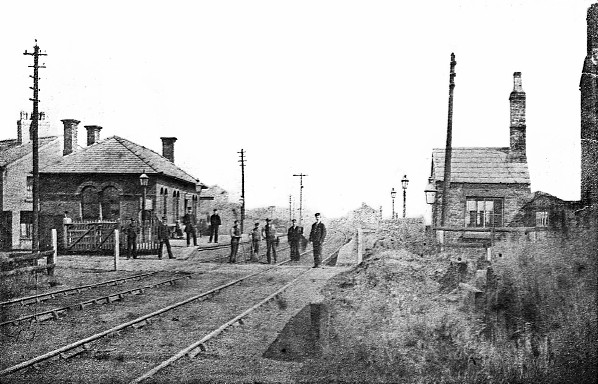
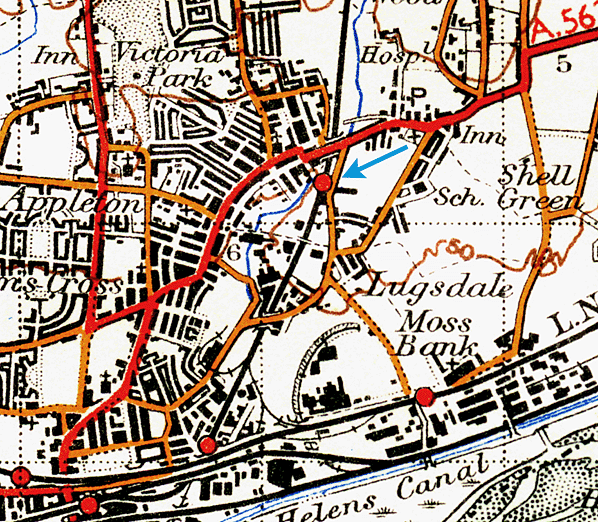
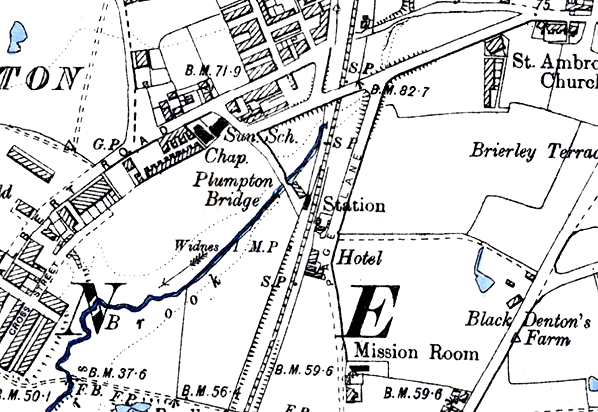
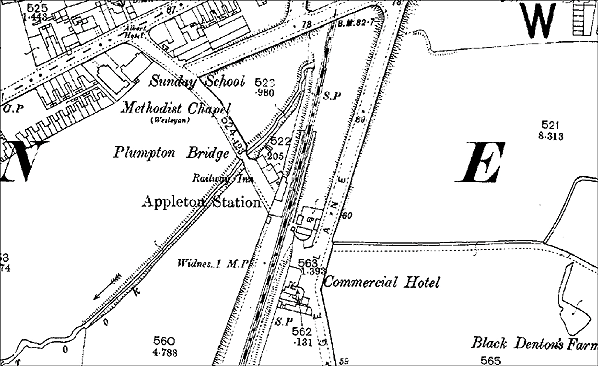
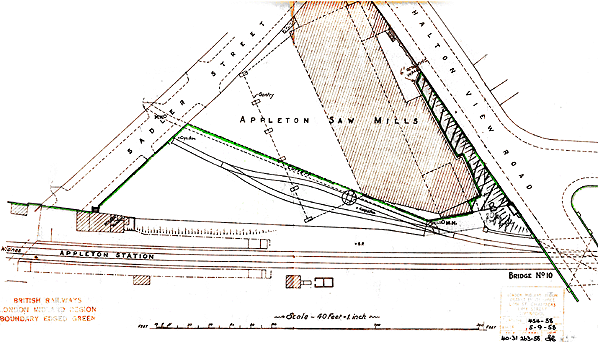 A 1958 drawing prepared by British Railways relating to the sale of the sawmill sidings which were no longer required
A 1958 drawing prepared by British Railways relating to the sale of the sawmill sidings which were no longer required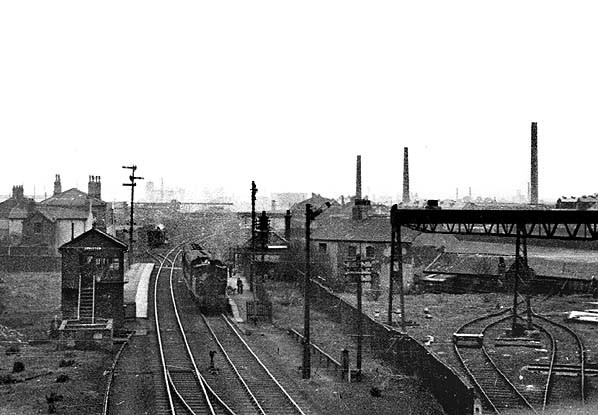
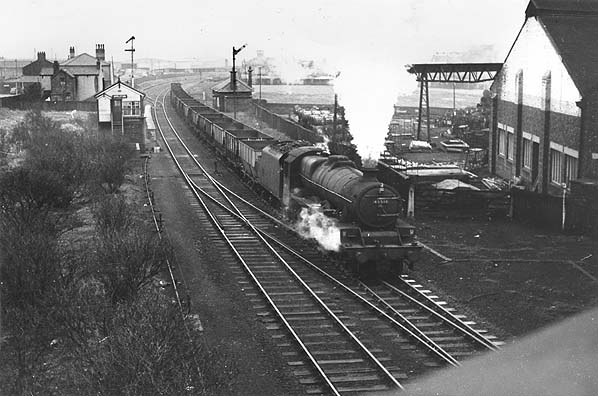
10.jpg)
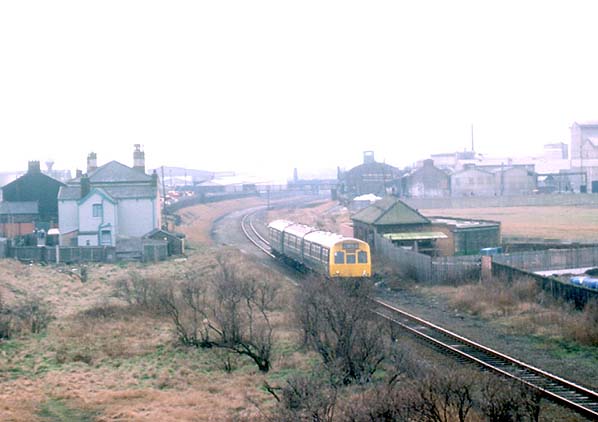
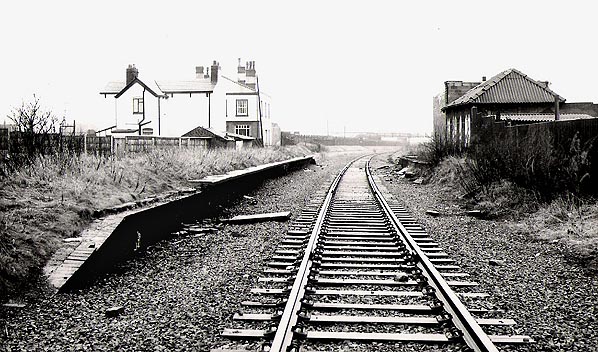
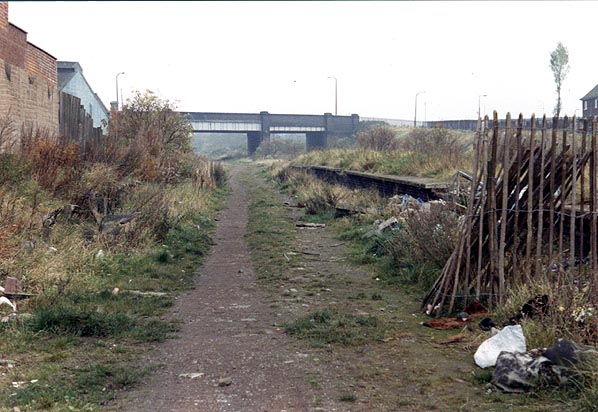
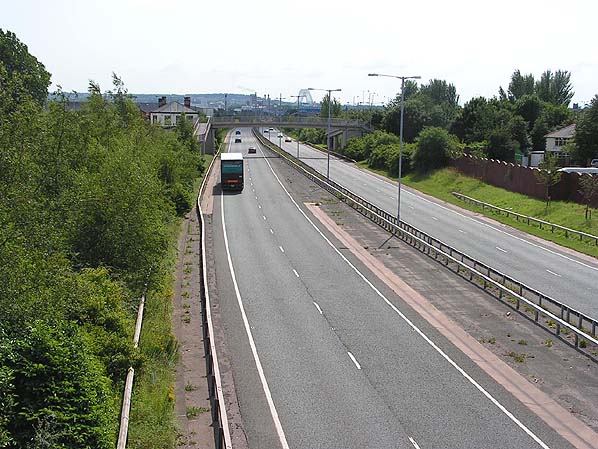
 The SH&RGR opened its line on 21 February, 1833 and it had given no thought to the provision of passenger services as it was built primarily to move coal from the St Helens area down to the banks of the River Mersey at Widnes Dock. Following the success of passenger services on the Liverpool & Manchester Railway (L&M) which opened in September 1830 the SH&RGR had been persuaded by local people to run a passenger service between St Helens Junction (on the L&M line) and St Helens, the northern terminus of its own line, as early as 1832 before it had opened as a through route. There was also pressure to operate a service between St Helens and Runcorn Gap. The company was persuaded, and they therefore hired two coaches from the Liverpool & Manchester Railway (LMR) at £1 per week. The SH&RGR did not operate specific passenger trains but merely attached the coaches to goods services. The only stations were at St Helens and close to Widnes Dock, the latter being named Runcorn Gap.
The SH&RGR opened its line on 21 February, 1833 and it had given no thought to the provision of passenger services as it was built primarily to move coal from the St Helens area down to the banks of the River Mersey at Widnes Dock. Following the success of passenger services on the Liverpool & Manchester Railway (L&M) which opened in September 1830 the SH&RGR had been persuaded by local people to run a passenger service between St Helens Junction (on the L&M line) and St Helens, the northern terminus of its own line, as early as 1832 before it had opened as a through route. There was also pressure to operate a service between St Helens and Runcorn Gap. The company was persuaded, and they therefore hired two coaches from the Liverpool & Manchester Railway (LMR) at £1 per week. The SH&RGR did not operate specific passenger trains but merely attached the coaches to goods services. The only stations were at St Helens and close to Widnes Dock, the latter being named Runcorn Gap. Appleton station was on the north side of a level crossing with two platforms. It had a simple single-storey brick building on the ‘up’ (St Helens direction) platform and a simple waiting shelter on the ‘down’ Widnes direction platform. A house for the stationmaster was provided on the east side behind the southbound platform. A small area of settlement, including two inns, developed around the station.
Appleton station was on the north side of a level crossing with two platforms. It had a simple single-storey brick building on the ‘up’ (St Helens direction) platform and a simple waiting shelter on the ‘down’ Widnes direction platform. A house for the stationmaster was provided on the east side behind the southbound platform. A small area of settlement, including two inns, developed around the station.
 During the Second World War the passenger service was cut back to only six trains per day in each direction, and they ran only in morning and evening peak hours. There were midday services on Saturdays for shoppers but, in the main, the line was given over to goods services and troop trains. At the end of the war Appleton’s passenger service remained sparse, although the trains that did run were popular with local people for travelling to work and on Saturday shopping trips.
During the Second World War the passenger service was cut back to only six trains per day in each direction, and they ran only in morning and evening peak hours. There were midday services on Saturdays for shoppers but, in the main, the line was given over to goods services and troop trains. At the end of the war Appleton’s passenger service remained sparse, although the trains that did run were popular with local people for travelling to work and on Saturday shopping trips. 

 Home Page
Home Page